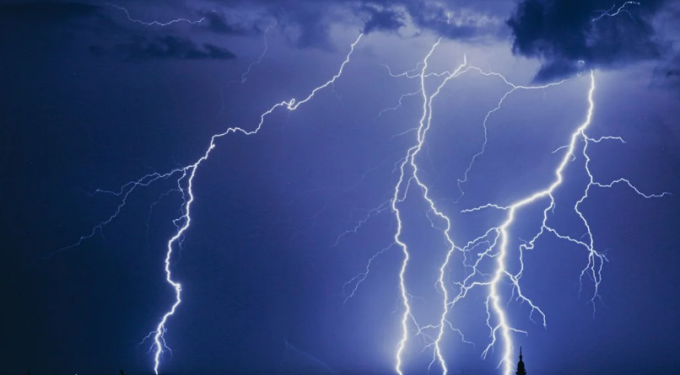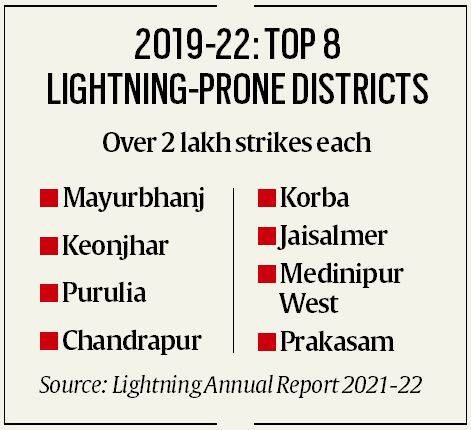Description

Disclaimer: Copyright infringement not intended.
Context
- Seventeen people have been killed by lightning over the last two days in various parts of Bihar due to lightning.
What is lightning?
- Scientifically, lightning is a rapid and massive discharge of electricity in the atmosphere some of which is directed towards earth. The discharges are generated in giant moisture-bearing clouds that are 10-12 km tall. The base of these clouds typically lies within 1-2 km of the Earth’s surface, while the top is 12-13 km away. Temperatures in the top of these clouds are in the range of –35° to –45°C.
Mechanism
- As water vapour moves upward in the cloud, the falling temperature causes it to condense. As they move to temperatures below 0°C, the water droplets change into small ice crystals. They continue to move up, gathering mass until they are so heavy that they start to fall to Earth. This leads to a system in which, simultaneously, smaller ice crystals are moving up and bigger crystals are coming down.
- Collisions follow and trigger the release of electrons, a process that is very similar to the generation of sparks of electricity. As the moving free electrons cause more collisions and more electrons, a chain reaction ensues. This process results in a situation in which the top layer of the cloud gets positively charged, while the middle layer is negatively charged. The electrical potential difference between the two layers is huge, of the order of a billion to 10 billion volts. In very little time, a massive current, of the order of 100,000 to a million amperes, starts to flow between the layers.
- While the Earth is a good conductor of electricity, it is electrically neutral. However, in comparison to the middle layer of the cloud, it becomes positively charged. As a result, about 15%-20% of the current gets directed towards the Earth as well. It is this flow of current that results in damage to life and property on Earth.
Which areas are lightning-prone?
- Climate Resilient Observing Systems Promotion Council (CROPC), which works closely with government agencies like the India Meteorological Department, releases an Annual Report that includes a lightning atlas which maps vulnerability at the district level.
- According to the report, Madhya Pradesh has reported the largest number of cloud to ground lighting strikes, followed by Chhatisgarh, Maharashtra, Odisha and West Bengal. Other states with high strike rate include Bihar, UP, Karnataka, Jharkhand and Tamil Nadu.

Impact of lightning
- In 2019-20, about 1.4 crore lightning strikes were recorded, which increased to 1.85 crore in 2020-21.
- In 2021-22, about 1.49 crore strikes were recorded across the country. The reduction, in line with the trend observed globally, has been attributed to the impact of the Covid-19 pandemic. The reason attributed to reduction in lightning is due to Covid-2019 pandemic induced reduction in aerosol level, pollution, environmental upgradation and relatively stable weather system in Indian subcontinent.
Concerns
- Despite of the above figures, lightning remains among the least studied atmospheric phenomena in the country.
- Just one group of scientists, at the Indian Institute of Tropical Management (IITM) in Pune, works full-time on thunderstorms and lightning.
- Occurrences of lightning are not tracked in India, and there is simply not enough data for scientists to work with.
- Often, safety measures and precautions against lightning strikes do not receive as much publicity as other natural disasters such as earthquakes.
Steps needed to be taken by the Government
- Common Alert Protocol (CAP) system to warn people about impending thunderstorm and lightning strikes.
- "Proactive steps" in building proper infrastructure to ensure safety of its people during natural hazards.
- Building a large number of cyclone shelters along the coastal areas, as done by Odisha.
- Media would need to play a crucial role in creating awareness on natural calamities.
- (IITM), Pune and Earth System Science Organization (ESSO) have developed an app, 'Damini', to monitor lightning activities.
- More than 96% of lightning deaths happen in rural areas. As such, most of the mitigation and public awareness programmes need to focus on these communities. Lightning protection devices are fairly unsophisticated and low-cost. Yet, their deployment in the rural areas, as of now, is extremely low.
- There is a need for more extensive study in the area and the Ministry of Earth Sciences is carrying out a research project on thunderstorms.
- States need to be encouraged to prepare and implement lightning action plans, on the lines of heat action plans.
- Set up an international centre for excellence on lightning research to boost detection and early warning systems.
https://indianexpress.com/article/explained/explained-lightning-strikes-kills-precautions-7979880/
1.png)















